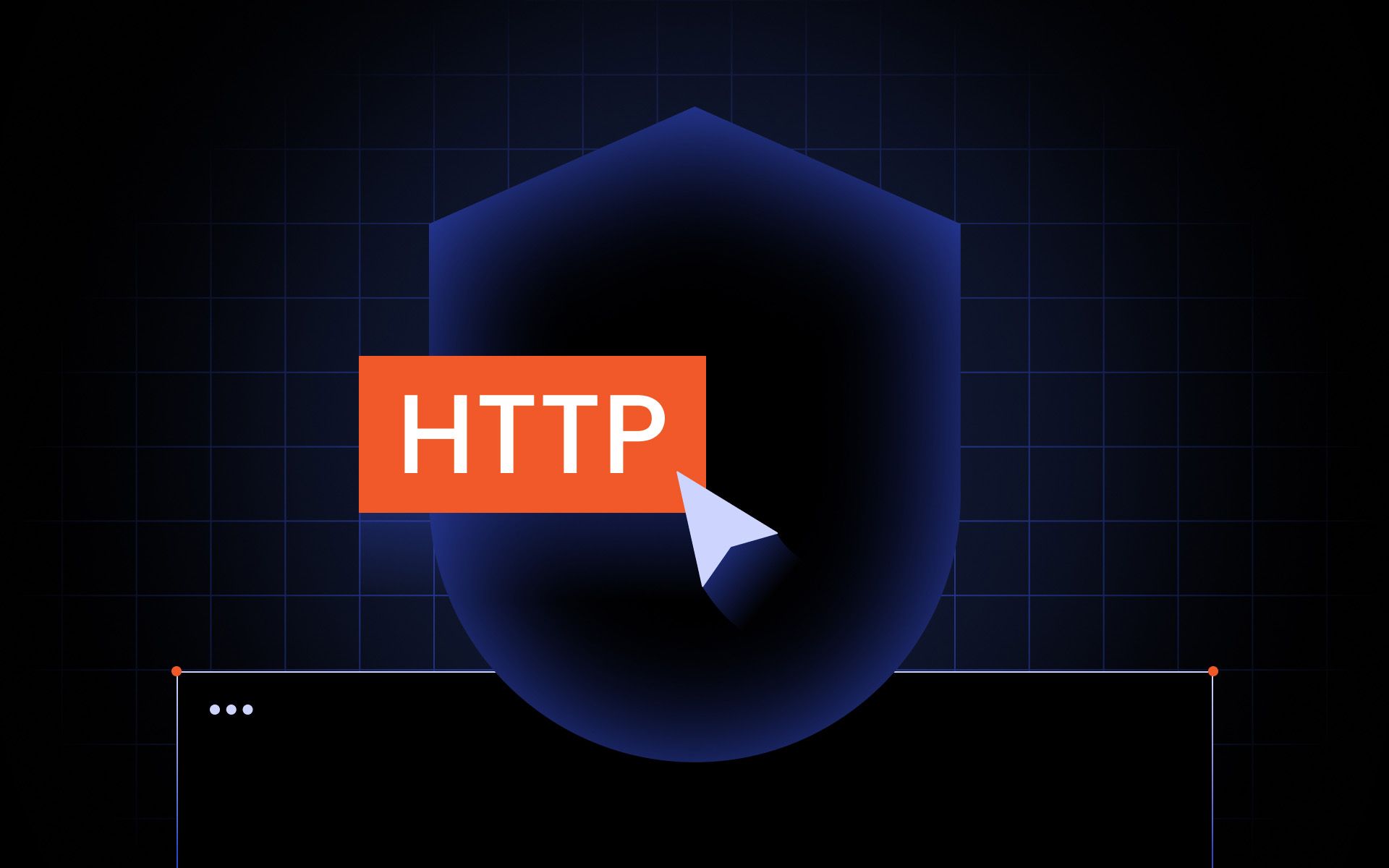When you want control over how your system talks to the internet, or how the internet talks back, you need a hypertext transfer protocol (HTTP) proxy server.
Thanks to its configuration, an HTTP proxy can see inside any web request. That means you can inspect, block, throttle, or rewrite traffic. Let’s talk about HTTP proxies and how they work.
Understanding HTTP and proxies
You can’t break down what an HTTP proxy does without first understanding the basics of HTTP. But to make sense of HTTP, you need to know how it works, and that means stepping into the Open Systems Interconnection (OSI) model. This model slices digital communication into seven distinct layers.
- Layer 7 - Application: Interfaces with apps like your web browser. HTTP and HTTPS are here.
- Layer 6 - Presentation: Handles data formatting, includes encryption and compression.
- Layer 5 - Session: Manages sessions and connections. Think login tokens and cookies.
- Layer 4 - Transport: Ensures data is delivered fully and in order. Transmission Control Protocol (TCP) resides here.
- Layer 3 - Network: Deals with IP addressing and packet routing.
- Layer 2 - Data Link: Handles device-level identifiers like MAC addresses.
- Layer 1 - Physical: The cables, airwaves, and power that move your bits.
When you make any type of request, the process starts at Layer 7. Here, your client constructs the request using the protocol you specified. It could be SOCKS5, FTP, HTTPS, or in our case, HTTP.
HTTP stands for Hypertext Transfer Protocol. Here’s what you need to know about it:
- It’s stateless
Every request is independent. The server doesn’t remember past requests from the same client. If you want memory, you build it with cookies, headers, or tokens.
- It’s text-based
HTTP messages are plain text. If someone intercepts the request, they can read it line by line without needing to decode anything.
- It’s request-response driven
You, the client, send a request. The server processes it and returns a response. That’s the entire exchange.
Now let’s talk about proxies.
How HTTP proxies work
A proxy server is a middleman in the request-response chain. Depending on its configuration, it intercepts your request, terminates it, and builds a new one to send to the target server. The target sees the proxy as the client and responds to it; the proxy then passes the response back to you.
There are many types of proxies out there. When choosing which one to use, you need to consider factors such as the source of IPs, whether they are static or rotating, and, in our case, the protocol they support.
A proxy server that routes requests through the HTTP protocol we discussed is known as an HTTP proxy. If you send an HTTP request through one, it will reroute your request to the target through HTTP.
Types of HTTP proxies
Even HTTP proxies come in many forms. They can be categorized by where they sit in the HTTP request-response chain and by how well they hide the client’s original IP.
Forward vs. reverse proxies
In every internet request, there are three key players:
- your web browser (or whatever client you’re using)
- the server you're connecting to
- the request itself
Where you insert an HTTP proxy in this chain determines whether you're dealing with a forward HTTP proxy or a reverse proxy.
Forward proxy
A forward HTTP proxy is a client-facing HTTP tool. It sits between the client and the open internet, inspecting and modifying requests before they ever reach the server.
You configure your browser or system to send requests to the proxy server first. From there, the proxy acts as the client, at least from the internet’s perspective.
Because this all happens over HTTP at Layer 7, the proxy has full visibility into the structure and meaning of the request. Let’s say you search for “residential proxies” in a browser configured to use a forward HTTP proxy. Depending on how you configure your proxy, here’s what it can inspect and log:
- HTTP method: The type of HTTP request the client is sending.
- Target host: The full domain or IP address that the request is trying to reach, typically from the host header.
- Path: The exact URL and search query you entered.
- Headers: Headers, including User-Agent, Host, and Accept.
- Request body: Full body of PUT, PATCH, and POST requests.
What Can You Do With a Forward HTTP Proxy?
There’s a lot you can do with the request visibility that forward HTTP proxies provide. Here are a few common use cases:
- Bypassing restrictions
When you route traffic through a proxy in a different country, the target site sees the proxy’s IP, not yours. This helps you bypass basic geo-blocks.
- Access and control filtering
A forward HTTP proxy server gives you full visibility into the structure of every outgoing request. You can block requests to specific paths, such as /downloads or /games, while still allowing others.
- Policy enforcement and logging
Organizations use forward HTTP proxies to log outgoing requests for policy enforcement or audit purposes.
- Caching and bandwidth savings
When one client downloads a file, the proxy stores a local copy. If others request the same file, they get it from the proxy instead of the internet. This saves bandwidth and speeds things up.
Reverse proxy
A forward HTTP proxy sits between your client and the internet, but a reverse HTTP proxy operates on the other side. It stands between your backend servers and the outside world, handling every incoming request on their behalf.
When users access web content through your site, it’s the reverse proxy that receives their traffic, inspects the full structure of the request, and decides which server behind it should respond.
If you run a high-traffic website or API, configure this proxy setup to keep your real infrastructure hidden and apply access controls before anything touches your backend. Because the proxy server lives at Layer 7, it understands every HTTP method, path, and header, letting you configure proxy logic to scale securely.
So how does a reverse HTTP proxy work in practice?
From the client’s perspective, they’re sending a request to your website. But in reality, that request is routed to a reverse proxy server, which then terminates the connection, reads the request, and takes over from there. Depending on how you configure your proxy server, it may:
- Strip an authorization header and inject a signed token for internal services.
- Route requests to upload files to a dedicated upload handler instead of the default app.
- Block requests if the IP matches a deny list or if the path triggers a rate limit.
- Add headers to preserve the client’s IP while staying transparent to your backend.
- Serve a cached version instead of waking your infrastructure.
Only after applying these rules does the reverse proxy open a new connection to the internal service. It relays the modified request, collects the response, and sends it back to the client as if it came directly from the origin server.
What Can a Reverse Proxy Do for Your Website?
Here's why you may configure a reverse proxy for your website:
- Load balancing
A reverse HTTP proxy can distribute incoming traffic across multiple backend servers.
- Caching
When a client requests static or semi-static content, like /docs, /pricing, or even whole HTML pages, the reverse proxy can intercept the request and respond directly with a cached version. The backend server never gets involved, saving resources and drastically reducing response times.
- Access control
If you only want specific users to access certain parts of your site, you can configure your reverse HTTP proxy to enforce this. The proxy inspects request headers, cookies, or paths, and drops anything that doesn’t match. You can also block entire regions by denying requests based on IP geolocation before they reach your backend.
Transparent, anonymous, and elite proxies
You can also choose HTTP proxies based on how they handle your IP address:
- Transparent proxies
A transparent proxy forwards your request to the target server without hiding that a proxy is involved. It passes along your original IP and leaves HTTP headers intact. These proxies aren’t designed for privacy. They are commonly used for access control, content filtering, traffic monitoring, and bandwidth saving through caching.
- Anonymous proxies
An anonymous proxy forwards your request without exposing your IP address, but the destination server can still detect that a proxy was used. These proxies are useful for basic public data scraping, bypassing geo-restrictions, and isolating traffic for testing or monitoring purposes.
- Elite proxies
Elite proxies offer the highest level of privacy. They hide both your IP and the fact that a proxy is being used, making the request appear to come from a legitimate client. They are ideal for sensitive transactions, bypassing geo-restrictions, advanced web scraping, and other stealth-critical tasks.
For maximum privacy, choose residential proxies. They use IPs from real devices, making them harder to detect and more reliable than datacenter alternatives.
What are the limitations of using HTTP proxies?
Depending on whether they hide or expose your IP and where they sit in the connection path, HTTP proxies can introduce risks and restrictions. Let’s break down the main limitations of using HTTP proxies:
- Header-based detection
Since proxies add headers, any trace they leave lets the server identify the proxy you used.
- IP reputation
The source and reputation of your HTTP proxy matter. If someone lists the proxy’s IP in an abuse directory or a target flags it as malicious, you’ll be blocked no matter which location you choose.
- Security risks
HTTP is unencrypted by design, so when you use an HTTP proxy to access a URL, the entire request is sent in plaintext. Anyone monitoring the traffic (between your device and the proxy, or between the proxy and the destination) can see everything. That’s why you shouldn’t use HTTP proxies to transmit sensitive information.
HTTP vs. HTTPS proxies
HTTP proxies can’t natively inspect HTTPS traffic. They’re best suited for secure environments where data breaches aren’t a concern. For more sensitive use cases, an HTTPS proxy is a better fit.
Key differences
Despite the name, an HTTPS proxy doesn’t send HTTPS requests on your behalf. It handles a special HTTP method called CONNECT, which tells the proxy to open a raw TCP tunnel to the target server. Once that tunnel is up, your client sends encrypted traffic through it. The proxy can't see the request content - it only knows which host and port you're connecting to.
That’s the biggest difference between an HTTP proxy and an HTTPS proxy. HTTP proxies can read and rewrite every part of a request. HTTPS proxies can’t. They’re blind to the headers, path, method, and body. All they do is move encrypted packets between your client and the server.
When to use each
Use HTTPS proxies when privacy is more important than control.
If you’re sending sensitive information, scraping HTTPS websites, or working in an untrusted network environment, configure your proxy settings to support HTTPS tunneling. They keep your web traffic encrypted from end to end. Neither the proxy nor an attacker in the middle can read what you’re doing.
HTTP proxies are still the tool of choice when you want control. You use them to shape the flow of web traffic, block or rewrite requests, and log activity. But if your priority is to access web content securely without compromising privacy, then you should configure your proxy to support HTTPS.
Conclusion
Now you know what an HTTP proxy server is and the ways it can shape web requests. Use HTTP proxies when you need control over web traffic, and HTTPS proxies when keeping data secure is the priority. For tips on choosing the right HTTP proxy server for your use case, join our Discord community!
Is using an HTTP proxy legal?
The legality depends on how you use it. Routing your web requests through a proxy server to protect your privacy or manage web traffic in a business is fine. Using a proxy for fraud, hacking, or unauthorized access to services is illegal.
Does an HTTP proxy hide your IP address?
It depends on the type of HTTP proxy server. A transparent proxy passes your real IP address to the target server. An anonymous or elite proxy server hides your IP address, making it appear that requests come from the proxy instead of your device.
What is the difference between an HTTP proxy and a VPN?
An HTTP proxy only handles traffic sent over HTTP. A VPN encrypts all traffic from your device, not just web browser traffic, and routes it through a secure tunnel. VPNs offer more complete privacy, while HTTP proxies give more control at Layer 7.
What are the risks of using free HTTP proxies?
Free proxy servers often come with hidden costs. Since HTTP traffic is unencrypted, the proxy operator can log your web requests, monitor activity, or inject ads. Free services may also recycle IP addresses with a poor reputation, increasing the chance of blocks. Paid providers reduce these risks by offering secure, reliable IP address pools.
Can I use an HTTP proxy for streaming geo-restricted content?
Yes, an HTTP proxy can help you access web content limited by geography. By routing requests through a proxy server in another country, the streaming site sees the proxy’s IP address, not yours. But many platforms actively block proxy IPs, so reliability may vary. For more consistent streaming, HTTPS proxies or VPNs are often better.



